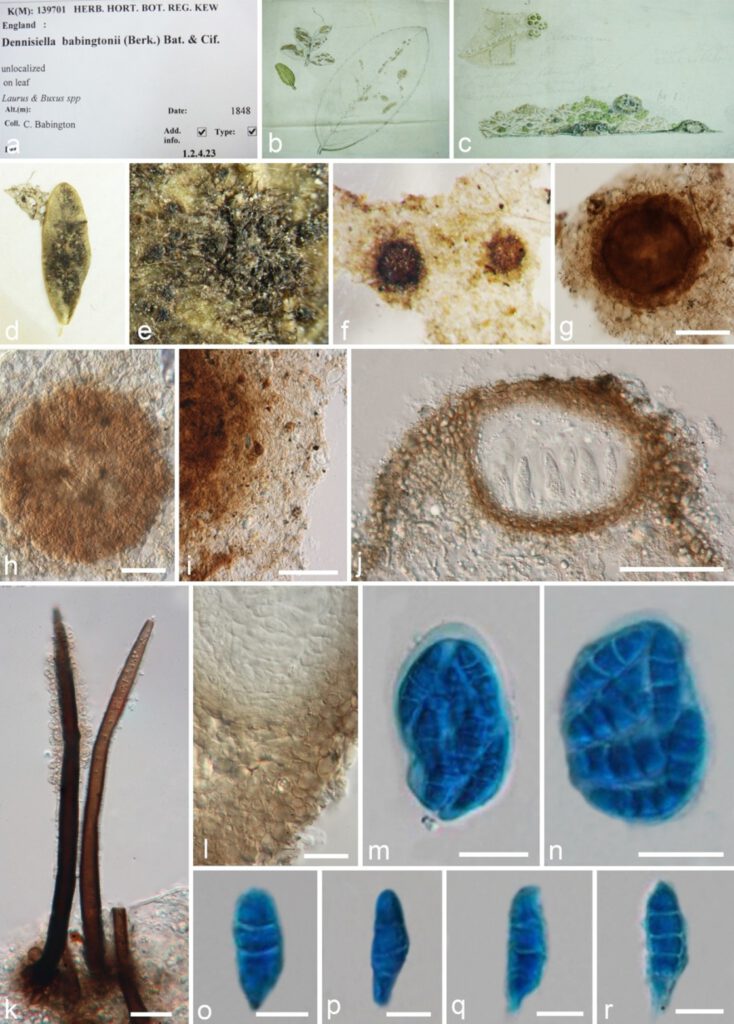Dennisiella babingtonii (Berk.) Bat. & Cif., Beih. Sydowia 3: 38 (1962), Figure 18
≡ Strigula babingtonii Berk., Suppl. Engl. Bot. 4: tab. 2957 (1849)
= Spermatodium babingtonii (Berk.) Trevis., Conspect. Verruc.: 12 (1860)
= Chaetothyrium babingtonii (Berk.) Keissl., Rabenh. Krypt.Fl., Edn 2 (Leipzig) 9(1.2): 446 (1937)
= Chaetothyrium babingtonii (Berk.) Dennis & M.B. Ellis, Trans. Br. mycol. Soc. 35(3): 199 (1952)
= Fumago fagi Pers., Mycol. eur. (Erlanga) 1: 9 (1822)
= Microxiphium fagi (Pers.) S. Hughes, Mycologia 68(4): 790 (1976)
= Botrytis fumago Fr., Syst. mycol. (Lundae) 3(2): 396 (1832)
= Capnodium footii Harv. ex Berk. & Desm., in Berkeley, J. hort. Soc., London 4: 254 (1849)
= Microxiphium footii (Harv. ex Berk. & Desm.) Thüm., Mycoth. Univ., cent. 14: no. 1352 (1879)
= Microxiphium footii f. minor Sacc., in Trotter, Syll. fung. (Abellini) 25: 262 (1931)
MycoBank number: MB 329804; Index Fungorum number: IF 329804; Facesoffungi number: FoF 10355;
Epiphytic or biotrophic on the leaves of Laurus spp. and Buxus spp. as sooty molds adpressed to the surface of host gaining nutrients from sugary exudates of sap-feeding insects. Subiculum well-developed, superficial, pelliculose, loose, blackish or grayish, comprising effuse, branched, subhyaline to olivaceous, 2–3 μm, septate hyphae, setose, reticulate. Setae erect, straight, tapering to the apex, bulbose at the base (Batista & Ciferri, 1962). Sexual morph: Ascomata 85–250 μm in diam. (x̅ = 187 μm, n = 10), superficial, sessile on subiculum, perithecial, scattered to aggregated, globose, circular when dry, uniloculate, brown to black, with periphysate ostiole, thick-walled, glabrous. Wall of ascoma 32–56 μm (x̅ = 43 μm, n = 10), multi-layered, externally comprising pigmented, dark brown, thick-walled cells of textura angularis, with inner layer thinner, composed of irregularly-shaped, flattened, lightly brown to hyaline, thin-walled cells of textura prismatica. Hamathecium lacking paraphyses. Asci 48–65 × 13–17 μm (x̅ = 55 × 16.2 μm, n = 10), 8-spored, bitunicate, fissitunicate, cylindrical to broadly clavate, shortly pedicellate or sessile, lacking a distinct ocular chamber. Ascospores 15–25 × 4–8 μm (x̅ = 21 × 6.8 μm, n = 10), overlapping bi-seriate or multi-seriate, irregularly arranged, fusoid, hyaline, 2–6 septate, slightly constricted at the septum, smooth and thick-walled, lacking a gelatinous sheath or appendages. Asexual morph: Undetermined.
Material examined: UK, unlocalized, on leaves of Laurus (Lauraceae) and Buxus spp. (Buxaceae), 1848, C. Babington (K(M) 139701, holotype of Strigula babingtonii).

Figure 18 Dennisiella babingtonii (K(M) 139701, holotype of Strigula babingtonii). a–d Herbarium material. e Appearance of ascostromata with setae on the superficial of the host. f–i Squash mount of ascoma. j Vertical section of ascoma. k Setae. l Vertical section through peridium. m, n Asci with ascospores. o–r Ascospores. Scale bars: g–j = 50 µm, l, k = 20 µm, m, n =10 µm, o–r = 5 µm.
